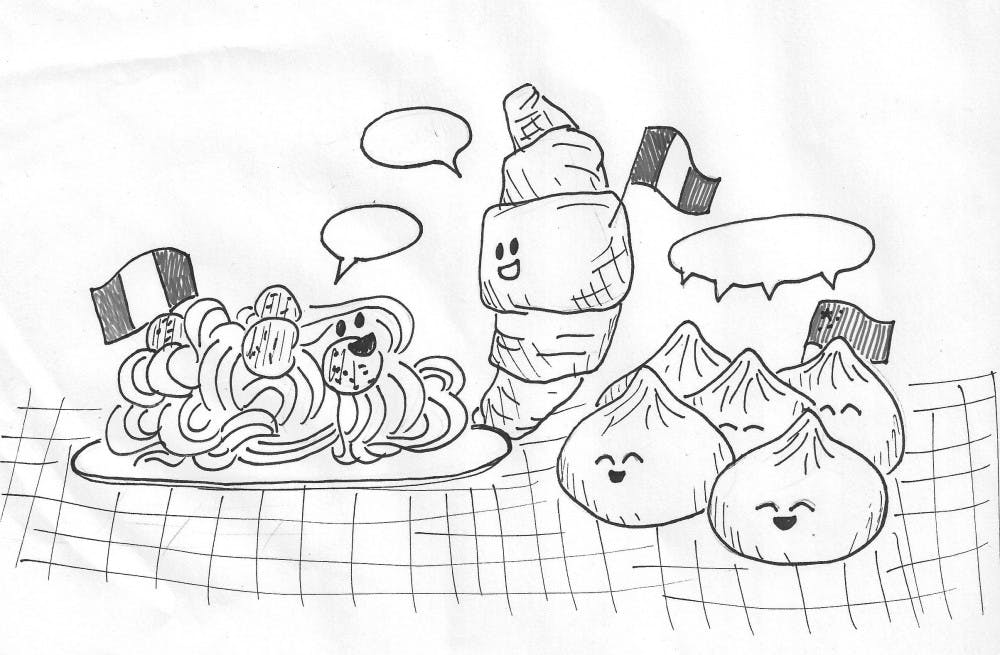As the leaves fall and the winds become harsher, there is a special urgency for the warmth and comfort of food. The large role food plays in daily life makes it “a very motivating subject for students,” said Esperanza Godoy Luque, visiting teaching associate in Hispanic studies. Luque teaches HISP0710: “Cultura Gastronomica de Espana,” one of several language courses at Brown featuring food as a key ingredient.
From classroom to kitchen
Soft tacos and falafel wraps aren’t the only items are dished up before students’ eyes in the Ivy Room, behind the kitchen doors, students have gathered to learn how to make tortilla de papas for Luque’s course.
At an intermediate to advanced level between language immersion courses and advanced literature courses, the Spanish gastronomy course demands a high level of proficiency, as it focuses on language in a specific context and very specialized vocabulary, said Elizabeth Gurin ’16, a student in the class.
Luque “said on the first day that this is not a cooking class but a course devoted to learning how to use the language in the context of food, food culture and food history,” Gurin said, adding that she has acquired a wider lexicon of food-related terms than she would have in other language courses.
Though primarily a language-oriented course in which students practice their language skills, receive critique and take tests, the course includes at least two cooking classes. Students also meet in smaller groups to cook outside of class and “write our reflections on the experience in Spanish,” Gurin said.
Luque decided to teach this course as a way to combine her love for teaching with her passion for Spanish food, she said. “Usually it’s difficult to find materials connected with gastronomy, an odd case for such a popular topic.”
But this has not been the case with Korean language courses. Paige Morris ’16, who began with the introductory KREA0100: “Korean” as a first-year and completed KREA0400: “Intermediate Korean” last semester, said each of her textbooks had at least one chapter devoted wholly to food, with the theme making additional appearances in other segments.
“Because our textbook was the primary source of information, which was largely dedicated to food culture, food had a big significance in our class curriculum,” she said.
But at the heart of these courses are the food-related topics and activities students themselves bring to class.
“There was no official unit in the textbook, but drinking culture came up a lot in class just because that was the knowledge that most of the students had prior to coming to class,” Morris said, adding that her professor taught them a Korean numbers game that alternatively serves as a drinking game.
Though Morris did not register for a Korean course this semester and has rarely practiced the language, “most of the memories (of the language) I still retain are those about food,” she said, adding, “I think that’s indicative of how food is integral to language.”
Debunking myths, learning traditions
Luque’s course aims to offer a holistic view of Spanish food culture and uncover its truths and misconceptions, Gurin said, citing molecular gastronomy, drinking culture, obesity and health as some of the topics covered in class.
“You hear about the wonders of the Mediterranean diet, but in reality there is a large problem with obesity in Mediterranean countries, just like there is in America,” Gurin said.
Camera Ford ’16, who has taken two Italian language courses, said much classroom time included discussion of Italian culture, with an emphasis on provincial cultures and their distinct features. Those cultural nuances are manifested through food, she said.
“We have a pretty monolithic idea about Italian food, like spaghetti and meatballs or pesto. But what we consider as Italian food is in fact from one specific region.”
One of the topics covered in her class was the slow food movement — a counter-movement to fast food culture — and the movement’s roots in traditional Italian cuisine, Ford said.
Traditional slow-cooking used to be “very important” in Italy, Ford said, describing the iconic image of a mother preparing pots for ragu sauce and spending all day in the kitchen.
“That’s how the symbolic dishes were created — from the process of mothers searching (for) whatever ingredients happened to be in the area,” she said. “It has given a particular set of cuisines that the world somehow became fascinated by.”
Though the German department has not offered a course that focuses on incorporating food into the curriculum, it celebrates its culinary traditions by holding cultural events.
“Weihnachtsmakt,” or the German Christmas market, is “usually held outside in the middle of a cold evening,” said Ivy Brenneman ’16, co-leader of the German DUG. During the market, visitors browse items for sale while sipping on hot spiced wine and listening to outdoor music. The department holds a similar event in which it prepares assorted Christmas snacks, including stollen, a sweet bread loaded with raisins and nuts and covered in powdered sugar.
Bringing people together
What Luque hopes her students will retain from the course is that “food is more than just food,” she said. “It is important for communication, important for family.”
Most of the students interviewed agreed with the connection Luque drew between food, culture and language.
“It’s something that a lot of people enjoy so it’s effective to talk about it. People get animated and you can compare your experiences with other people both within and outside the class,” Gurin said.
“Food brings people together,” Brenneman said. The department holds a Cafe Stunden every Friday, where students “eat and talk and bond over eating and talking.”
There is “less pressure” in this informal atmosphere, Brenneman said, adding that “people are less afraid to speak and make mistakes.”

ADVERTISEMENT




